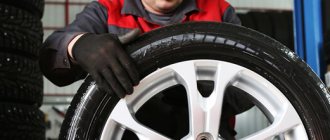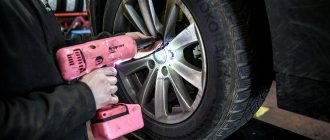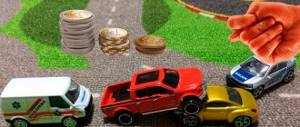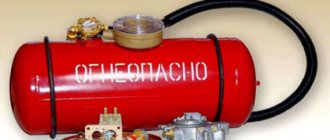Changing tires is mandatory for every road user, and this is no longer associated with the possibility of getting a fine, but with the need to ensure safety.
Dear readers! The article talks about typical ways to resolve legal issues, but each case is individual. If you want to find out how to solve your particular problem , contact a consultant:
+7 (499) 938-81-90 (Moscow)
+7 (812) 467-32-77 (Saint Petersburg)
8 (800) 301-79-36 (Regions)
APPLICATIONS AND CALLS ARE ACCEPTED 24/7 and 7 days a week.
It's fast and FREE !
What is the danger
Using the wrong type of tires on a car can lead to an emergency on the road and cause tragic consequences of an accident.
Risks associated with incorrect vehicle wheel fittings:
- Tire damage. Winter tires wear off on warm asphalt surfaces tens of times faster in the summer season.
- Increased braking distance due to increased sliding of winter tires on warm surfaces, and summer tires on icy surfaces.
- Skidding and risk of overturning due to insufficient grip and poor cornering.
Penalties for winter tires in summer
Previously (until 2015), there were no fines for wearing winter tires in the summer and vice versa, but the increase in accidents and deaths on the roads forced the Government to think and draw up a regulation on the mandatory imposition of fines for such violations.
From the regulations regarding tires it is clear that a violation for which a fine must be imposed is driving on a winter tire during the three summer months and, conversely, on a summer tire in the winter. It is also illegal to use different types of tires on vehicle axles. It is also worth noting that there are some adjustments for regional climate.
Size
The fine that was planned to be introduced when considering the bill was two thousand rubles, but this norm was not introduced.
At this stage, people are fined for tires, based on an article from the Code of Administrative Offenses “on the non-compliance of transport with technical parameters” (Article 12.5 of the Code of Administrative Offenses). The fine for driving on winter tires in summer is five hundred rubles. There is no provision for an increase in the amount of punishment in case of repeated detection of non-compliance.
Discount
In order to prevent the accumulation of unpaid fines, the inspectorate offers a discount of fifty percent. This service works as follows: if an inspector fines a driver for a minor violation, then the owner of the car can pay only half of the fine due in the next twenty days.
Therefore, the penalty for inappropriate tires on wheels can be only 250 rubles.
How much is the fine for tires out of season 2021?
Now regarding the fine. There is no penalty as such under the law. There is a lot of controversy that there is already a fine for winter tires from November 1st. After all, there are regulations. To do this, let’s touch on the very beginning and figure out what stage the project is at.
There are current technical regulations of the Customs Union. At the stages of its consideration in 2013, deputy V.A. Tyulpanov suggested making changes. Since initially and to this day, according to the law, they have no right to fine for non-compliance with the seasonality of wheels. However, there were disagreements with the regulations and the changes were sent for revision. After revision, Tyulpanov again amended the regulations, requiring a fine of 2,000 rubles to be paid for driving on studded wheels in the summer and driving on summer tires in the winter. However, these amendments were postponed again due to difficulties with the regulations. There were also proposals to increase the fine, due to its lack of motivation, since a set of tires costs much more and some motorists would prefer to pay a fine and continue driving on out-of-season wheels. Becoming an object of increased danger on the road.
On October 18, 2021, the State Duma held the first readings of the bill and the introduction of 2,000 rubles for traffic police fines for summer tires in winter and vice versa. But the second reading did not happen and the project was again postponed for at least half a year for revision. The traffic police officially confirmed that there is no fine in winter and summer.
Types of rubber
There are three main types of shoes for wheels:
- Summer.
- Winter.
- All-season.
Summer tires
The main indicators that you need to focus on when choosing tires for the summer season are the tread pattern and its height.
If the height is clear, no one will sell new tires with a height lower than that required by traffic regulations (an exception may be the purchase of used tires), then based on the type of pattern, tires are distinguished into:
- the symmetrical tread pattern is a classic and the most common model for driving on dry surfaces;
- the asymmetrical pattern has better traction and drains water from under the tires more efficiently;
- An incorrect, incomprehensible pattern on the wheels suggests that water is drawn out from under the car in different directions, which provides better traction.
Winter tires
Divided into two subspecies:
- studded;
- without thorns;
- universal (with the ability to insert spikes).
Which type to buy depends on the driver’s experience and terrain conditions. Studded wheels are a lifesaver during icy conditions and frost, but when driving on dry asphalt they can damage the surface, wear out a lot and slip. Also, in different situations, such tires have different braking distances.
Rubber without studs is not inferior to studded tires when driving on snowy roads, but eliminates the possibility of wheel locking when driving on dry terrain.
All-season
Rubber, which is designated as rain. A special feature of tires is the location of the patterns and the depth of the treads. The function of these wheels is to quickly remove water from under the car during the rainy seasons, thereby improving traction.
Penalty for bald tires, tread height
Tires worn out (worn out) during operation are not able to provide the necessary grip on the road surface, which leads to the car sliding and skidding on a snowy road.
Therefore, there is a taboo on bald tires with low residual tread height (Technical Regulations Appendix 8, Article 5.6; PP No. 1090 Basic provisions for vehicle approval p. 5; PP No. 127 List of faults, p. 5).
The maximum tread wear is tied to the residual tread depth in millimeters:
- 1.6 for cars;
- 2.0 for buses;
- 1.0 for trucks;
- 0.8 for motor vehicles.
For winter tires with markings in the form of a snowflake on the background of a 3-peaked peak, a limit of 4 mm has been introduced. The same tread minimum applies to tire markings MS, M+S and M&S.
Obviously, you should not allow extreme wear rates and worry about changing tires a little earlier. The indicated tread height is necessary for high-quality water drainage and to prevent loss of traction, which causes the vehicle to become uncontrollable on a wet road (hydroplaning).
Driving on the road with bald tires is punishable by a fine of 500 rubles (Administrative Code Art. 12.5 clause 1). An amendment to increase the fine has been discussed in the Duma for 2 years, but has not yet been legalized.
It is recommended to measure the tread height once a year. The service life directly depends on the manufacturer (price category) of the rubber and usually ranges from 2 to 6 years, although, admittedly, this indicator is difficult to average.
The trained eye of a professional will accurately identify “baldness” offhand. The everyday (folk) version of measuring with a 2-ruble coin has not yet failed a single car owner. And yet it is worth focusing on the wear indicator (if there is one), recessed into the relief of the tires of many manufacturers or presented in the form of a number. Absolutely accurate measurement of the tread groove can be carried out with a special auto-device or vernier caliper.
For a variety of reasons, hair loss usually occurs unevenly. Therefore, the level should be determined by the most worn area (GOST R 51709-2001 clause 5.5.1.1).
Tire requirements
Everything is actually individual and is purchased at the discretion of the car owner.
But there are basic indicators, due to non-compliance with which I apply penalties:
- During the three months of flight, the height of the tire tread on the wheels of the car must be at least 1.6 millimeters.
- In the winter season, the height of the gutters on the rubber should be higher than 4 millimeters.
The inspector cannot fine for the presence of studs when driving in dry winter weather or with a tread pattern suitable for rainy weather.
If there are these weather inconsistencies, a traffic police officer can explain to the driver the possible risks and advise him to continue driving with greater caution, especially when driving during heavily congested roads, as in Moscow.
When to change
The period for changing tires is legally established in the technical regulations of the Customs Union “On the safety of wheeled vehicles.”
From the document it follows that:
- Spikes cannot be used in the summer. Tires with high treads are replaced with lighter ones (summer or all-season) during daytime temperatures from +7 - +8 degrees in the absence of night frosts over the last three days.
- Winter tires should be on the car if the air temperature does not reach +5 degrees.
The tire change time may be slightly adjusted due to the climate in a particular region.
You can change tires either at a service center or on your own if you have the necessary skills.
What else can you be fined for?
At the end of the traffic rules there is a list of requirements under which the operation of vehicles is prohibited. There is a separate item dedicated to tires. It describes what requirements need to be taken into account when installing certain tires. For example, the tire tread depth should be at least:
- 1 mm - for cargo vehicles;
- 1.6 mm - for cars;
- 0.8 mm - for motorcycles;
- 2 mm - for buses.
For winter tires it must be at least 4 mm.
The following points indicate that there should be no damage to the tires. These include tread separation or various cuts. It is prohibited to install different tires or tires not intended for this type of transport on one vehicle
Using tires with any damage may result in the car owner being fined and getting into an accident.
The presence of cracks in the disc or loose bolts/nuts on the wheel - these types of damage also imply that the vehicle is not allowed to be operated with them.
If all these rules are not followed, traffic police inspectors have the right to impose a fine on the driver in the amount of 500 rubles, according to Part 1 of Article 12.5 of the Administrative Code. Instead of a fine, a regular, verbal warning may be issued. Such a punishment is imposed only when operating your vehicle on icy or snowy roads.
What to do if you received a traffic police fine by mistake? The driver's procedure in this case is described here. If you paid it twice and don’t know how to get the money back for the fine you paid again, then read this article.
This type of fine is called a fine for “bald” tires, since driving on the road with already worn tires is the most common violation committed by motorists.
If you use studded tires, then you must install the “Spikes” sign on your car.
If we talk about studded tires, then no sanctions are imposed for driving them in the summer. It’s another matter if you use it without the “Spikes” sign. Then you may be fined 500 rubles.
What is not recommended to do
When choosing tires, many may give preference to tires that do not match the parameters of the car.
It is forbidden:
- Put tires of the wrong diameter on the wheels.
- Change standard-sized wheels to smaller ones or, conversely, larger ones.
- Install studs on a universal tire yourself.
The purpose of changing tires seasonally is to ensure safe driving. You should not neglect this responsibility, because we are not talking about a five hundred ruble fine, but about people’s lives.










